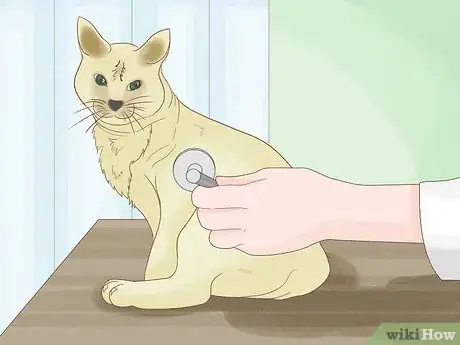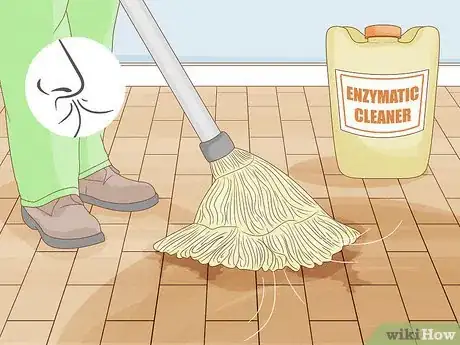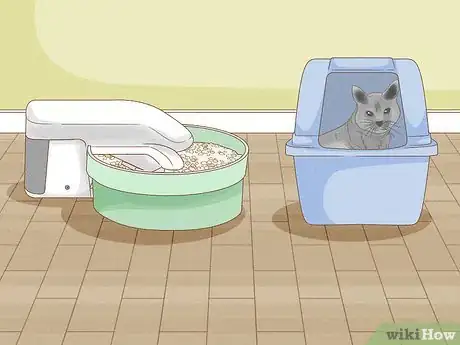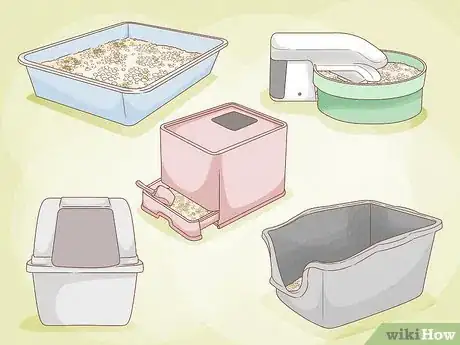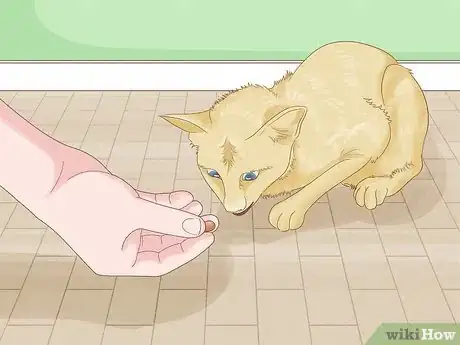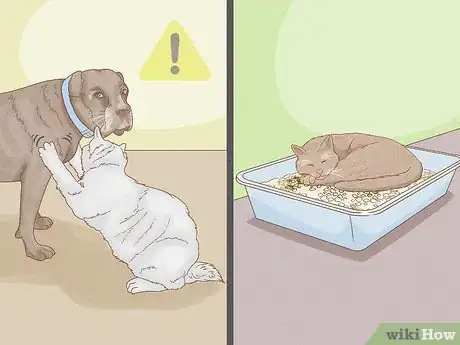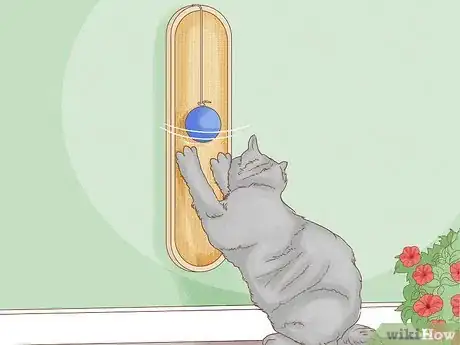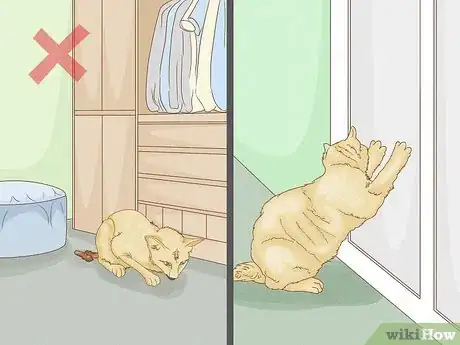This article was co-authored by Carrie Seay, MS-CABAC, KPA-CTP, CBCC-KA and by wikiHow staff writer, Megaera Lorenz, PhD. Carrie Seay is a Feline Behavior Consultant and the Owner of Carrie Pawpins based in Phoenix, Arizona. With over a decade of experience, she specializes in working with cat owners to prevent and eliminate cat behavioral issues. Carrie holds a Bachelor’s degree in Biology from Northern Arizona University and a Master’s degree in Companion Animal Behavior Analysis & Counseling from The American College of Applied Science. She has multiple certifications from well-known training programs like Karen Pryor academy.
There are 9 references cited in this article, which can be found at the bottom of the page.
This article has been viewed 6,409 times.
It can be frustrating when your cat starts pooping on the floor, on the carpet, or in other inappropriate areas. But the good news is that you can usually solve this problem with a bit of time and patience. In this article, we’ll talk about a few of the common reasons why your cat might be pooping on the floor, as well as the best ways to get your furry friend back into the habit of using the litter box.
Steps
Bring your cat to the vet for a checkup.
-
Medical problems are a common reason for inappropriate soiling. If your cat has recently started pooping outside the litter box, it’s important to rule out any health problems that could be causing the issue. Call your vet right away and set up an appointment for a checkup. With the right medical treatment, the problem behavior may go away.<refhttps://petkeen.com/how-to-stop-cat-from-pooping-on-the-floor/</ref>[1] X Research source
- Some common health problems that could cause your cat to go outside the litter box include constipation, colitis, or a problem with the anal glands.
- Let your vet know if you’ve noticed any other symptoms, or if there have been any recent changes to your cat’s diet or lifestyle that could be related to the problem.
Clean up any soiled spots quickly with an enzymatic cleaner.
-
If there’s a lingering smell, your cat may be tempted to go there again. Dispose of the poop as soon as you notice it, then use an odor-eliminating cleanser to thoroughly wash the area. Try an enzyme-based cleaner designed to break down pet odors.[2] X Research source
- Don’t use strong-smelling chemicals like vinegar or ammonia. Not only could they irritate your cat’s airways and skin, but the strong odors might encourage your cat to keep using the area as a toilet.[3] X Research source
- Follow the directions on the cleanser to make sure you’re using it correctly. For instance, you may need to let it sit on the stain for several minutes before wiping or rinsing it away.
Scoop the litter daily and change it once a week.
-
Some cats are very picky about the state of their litter. To keep the litter box as appealing as possible, scoop it every day. Empty all the litter and clean out the box thoroughly at least once a week, or every few days if you have multiple cats.[4] X Research source
- Avoid using harsh or strong-smelling cleaning chemicals when you clean the box, since the fragrance might bother your cat. Stick to warm water and mild dish soap.[5] X Trustworthy Source The Humane Society of the United States National organization devoted to the promotion of animal welfare Go to source
- If your litter box has picked up a lot of set-in, lingering odors that don’t come out easily when you clean it, it might be time to replace it.
Try moving the litter box to a new location.
-
Pick a spot that’s quiet and private. Just like humans, cats like peace and quiet when they do their business. Put the litter box in a location that doesn’t get a lot of noise and foot traffic, away from your cat’s food and water dishes.[6] X Research source
- Wherever you put the litter box, make sure your cat is always able to access it. If your cat can’t get to its bathroom, it’s more likely to go where it isn’t supposed to.
- Choose a spot that feels quiet and safe, but not too restrictive or closed in. You don’t want your cat to feel cornered or claustrophobic while going to the bathroom.[7] X Trustworthy Source American Society for the Prevention of Cruelty to Animals Leading organization dedicated to the prevention of animal cruelty Go to source
Set up at least one extra litter box.
-
This is especially important if you have multiple cats. Your cat may be more likely to use the litter box if it has more than one box to choose from. Aim to have at least one litter box per cat, plus one extra. If you have several cats, try to keep the litter boxes in separate areas of your home, especially if your cats are territorial or don’t get along well.[8] X Trustworthy Source The Humane Society of the United States National organization devoted to the promotion of animal welfare Go to source
- This will help take some of the pressure off if your cat is territorial and doesn’t like to share a bathroom area with other cats.
Experiment with different kinds of litter boxes.
-
Look for a box that your cat can use comfortably. For instance, your cat might prefer a box without a lid, or a larger box rather than a more compact one. You can even set up several different types of boxes, then observe your cat’s bathroom habits to figure out which kind it likes best.[9] X Trustworthy Source American Society for the Prevention of Cruelty to Animals Leading organization dedicated to the prevention of animal cruelty Go to source
- Some cats like having lots of space to do their business. Try using a large, shallow plastic storage bin instead of a regular litter box if your pet needs extra room.
- If you have an older cat or a cat with mobility issues, go for a litter box with low sides so it’s easier for your kitty to climb in and out. You can also get a litter box ramp or steps for easier accessibility.
Switch to a new type of kitty litter.
-
Your cat may be sensitive to certain smells and textures. Experiment with different types of litter until you find one that your cat seems to prefer. Most cats like unscented, clumping litters best. They may be irritated by litters with strong odors or a coarse texture.[10] X Trustworthy Source American Society for the Prevention of Cruelty to Animals Leading organization dedicated to the prevention of animal cruelty Go to source
- One easy way to tell what kind of litter your cat likes best is to set up 2 or more litter boxes side by side. Put different types of litter in each box, then pay attention to which box your cat prefers to use.[11] X Research source
Keep the litter level no higher than 2 inches (5.1 cm) deep.
-
Cats prefer to go in shallow litter. To make sure your cat feels as comfortable as possible, pour about 1–2 inches (2.5–5.1 cm) of litter into the box. If it’s any deeper, your cat might be tempted to skip the litter box and go elsewhere.[12] X Trustworthy Source American Society for the Prevention of Cruelty to Animals Leading organization dedicated to the prevention of animal cruelty Go to source
Add an herbal cat attractant to the litter box.
-
The smell might make the box more inviting. Look for an attractant powder that’s designed for use in kitty litter. Mix it into your cat’s litter according to the directions on the package.[13] X Research source
- You can also buy specialized litters with cat attractants already mixed in.
- Look for these products at your pet supply store. You may also be able to buy them from your vet’s office.
- Litter attractants are typically made with a blend of herbs that smell pleasant to cats. Common ingredients include lavender, sage, calendula, echinacea, and spearmint.[14] X Research source
Reward your cat for using the litter box.
-
Offer them a treat right after they use the box. This might encourage your cat to keep using the litter instead of going on the floor.[15] X Research source You can also try speaking to your cat in a quiet, encouraging voice whenever you see it go where it’s supposed to.
- Be consistent with the reward, and offer it as soon as you see your cat come out of the litter box. That way, your cat will be more likely to associate the reward with the good behavior.[16] X Research source
- Most cats respond best to food rewards. Offer a favorite treat or a little bit of wet food.
Startle your cat if you catch it in the act of soiling the floor.
-
Squirt it with a water gun or rattle a jar of coins. This will startle your cat and interrupt it from doing its business, but it shouldn’t scare or stress it too much. If your cat comes to associate going in the wrong place with an unpleasant noise or an annoying spray of water, it might be discouraged from doing it again. Try to do this as soon as you notice your cat getting ready to go (e.g., if you see it scratching or squatting) rather than after it’s already started or finished.[17] X Research source
- Don’t try to scare, punish, or discipline your cat. Stressing your pet will only make the problem worse.
- You can also try saying “no,” then calmly picking your cat up and putting it in the litter box. Use a firm voice to get your cat’s attention, but don’t yell, since this could scare the cat.
Reduce sources of stress in the home.
-
Cats sometimes go outside the box when they’re anxious. Think about anything that might have happened recently to trigger the new behavior. For example, have you brought a new pet into the home, or has there been a change in your daily routine? Did you switch to a new brand of cat food or litter? If you notice that anything in particular seems to be bothering your feline friend, look for ways to minimize the source of stress as much as possible.[18] X Trustworthy Source American Society for the Prevention of Cruelty to Animals Leading organization dedicated to the prevention of animal cruelty Go to source
- For instance, if your cat has been getting into fights with another pet, try to keep them separate when you’re not around to supervise their interactions.
- Keep your cat’s routine as consistent as possible. For instance, try to feed and groom it at the same times and in the same locations each day.
- If you can’t eliminate causes of stress, you can also try a calming aid such as a pheromone diffuser, spray, or collar. You can get these products at most pet supply stores or vets’ offices.
Give your cat toys to keep it busy.
-
Your cat might be misbehaving because it’s bored. Make sure your pet has plenty of fun toys to keep it entertained. Set up an interesting environment with scratching posts, perches, and places where your cat can hide and rest when it feels stressed or overstimulated.[19] X Research source
- You can also try playing with your cat near the litter box or leaving toys close to the litter area to make it seem more inviting.[20] X Trustworthy Source American Society for the Prevention of Cruelty to Animals Leading organization dedicated to the prevention of animal cruelty Go to source
- Cats can also get stressed and go outside the box if they’re lonely or not getting enough attention. Spend time petting and playing with your cat every day to keep it entertained and make sure it feels loved.
Put down tinfoil in areas where your cat poops.
-
Double-sided tape may also discourage your cat. It could be that your cat simply enjoys going in a particular spot outside the litter box. If that’s the case, it might be enough to make their unauthorized bathroom area less appealing.[21] X Research source Try laying down a layer of aluminum foil, since some cats dislike the texture and sound of foil under their feet.[22] X Research source Other possible deterrents include:
- A layer of double-sided tape or sandpaper.
- A motion-activated, odor-based deterrent spray. Some scents that cats dislike include citrus, lavender, cayenne pepper, and peppermint.[23] X Research source
- An electrified mat that can deliver a mild but annoying shock when your cat walks on it.
- A plastic training mat with a prickly surface that won’t harm your cat, but is irritating to walk on.
Restrict your cat’s access to areas where it likes to poop.
-
This may help get your cat back into the habit of using the litter. If nothing else is working, try closing off the area where your cat likes to poop. You may also need to restrict your cat to a smaller space for a while, such as a single room where it has never pooped in any inappropriate areas before. Make sure your cat has access to everything it needs, such as food, water, toys, and a comfortable place to sleep.[24] X Research source
- In rare cases, you might need to confine your cat to a really small space for 1-4 weeks, such as a large cat or dog cage with a litter pan and a sleeping ledge.
- You may not have to keep your cat totally confined for the entire time. You can let your cat out as long as you’re around to supervise it, then put it back in the enclosed area when you’re not there (for example, at night or when you have to go to work).
Ask your vet about calming medications.
-
Anti-anxiety meds can help control unwanted bathroom behaviors. If other approaches aren’t working, your vet might be able to prescribe something that can help. They’ll probably recommend using medications in combination with other methods, like adjusting your litter cleaning routine or providing more litter boxes.[25] X Research source
- Your vet might also be able to recommend an animal behavior specialist who can work with you and your cat if the problem has gotten really out of hand.
You Might Also Like



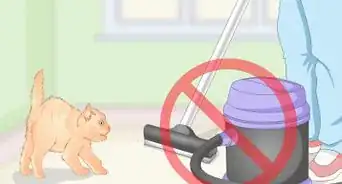






References
- ↑ https://vcahospitals.com/know-your-pet/cat-behavior-problems-house-soiling
- ↑ https://www.bucksburnvethospital.com/2019/11/14/why-does-my-cat-poop-outside-the-box/
- ↑ https://www.vet.cornell.edu/departments-centers-and-institutes/cornell-feline-health-center/health-information/feline-health-topics/feline-behavior-problems-house-soiling
- ↑ https://vcahospitals.com/know-your-pet/cat-behavior-problems-house-soiling
- ↑ https://www.humanesociety.org/resources/preventing-litter-box-problems
- ↑ https://www.vet.cornell.edu/departments-centers-and-institutes/cornell-feline-health-center/health-information/feline-health-topics/feline-behavior-problems-house-soiling
- ↑ https://www.aspca.org/pet-care/cat-care/common-cat-behavior-issues/litter-box-problems
- ↑ https://www.humanesociety.org/resources/preventing-litter-box-problems
- ↑ https://www.aspca.org/pet-care/cat-care/common-cat-behavior-issues/litter-box-problems
- ↑ https://www.aspca.org/pet-care/cat-care/common-cat-behavior-issues/litter-box-problems
- ↑ https://www.bucksburnvethospital.com/2019/11/14/why-does-my-cat-poop-outside-the-box/
- ↑ https://www.aspca.org/pet-care/cat-care/common-cat-behavior-issues/litter-box-problems
- ↑ https://www.bucksburnvethospital.com/2019/11/14/why-does-my-cat-poop-outside-the-box/
- ↑ https://cats.lovetoknow.com/cat-products/litter-additives-attract-cats
- ↑ https://vcahospitals.com/know-your-pet/cat-behavior-problems-house-soiling
- ↑ https://www.hshv.org/training-cats-with-positive-reinforcement/
- ↑ https://www.vet.cornell.edu/departments-centers-and-institutes/cornell-feline-health-center/health-information/feline-health-topics/feline-behavior-problems-house-soiling
- ↑ https://www.aspca.org/pet-care/cat-care/common-cat-behavior-issues/litter-box-problems
- ↑ https://www.bucksburnvethospital.com/2019/11/14/why-does-my-cat-poop-outside-the-box/
- ↑ https://www.aspca.org/pet-care/cat-care/common-cat-behavior-issues/litter-box-problems
- ↑ https://www.vet.cornell.edu/departments-centers-and-institutes/cornell-feline-health-center/health-information/feline-health-topics/feline-behavior-problems-house-soiling
- ↑ https://www.bucksburnvethospital.com/2019/11/14/why-does-my-cat-poop-outside-the-box/
- ↑ https://www.cityofsacramento.org/-/media/Corporate/Files/General-Services/Animal-Care/Feral-Cat-Deterrents.pdf?la=en
- ↑ https://vcahospitals.com/know-your-pet/cat-behavior-problems-house-soiling
- ↑ https://vcahospitals.com/know-your-pet/cat-behavior-problems-house-soiling
About This Article

